Below is a complete 100‑shot prompt pattern library for ecommerce product pages with before/after examples and copy‑paste templates, structured around proven frameworks like AIDA, PAS, BAB, and FAB plus core prompt‑engineering patterns for consistency and quality.
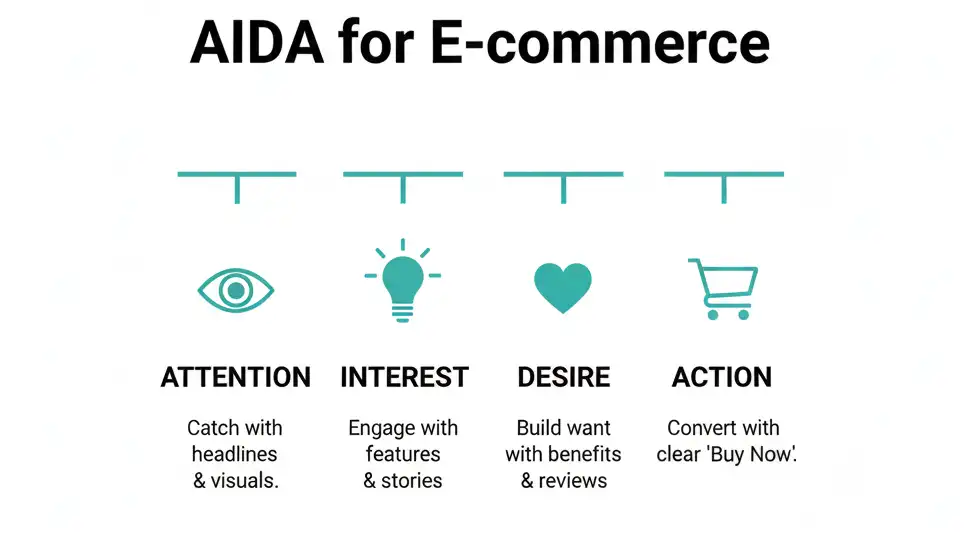
How to Use This Library
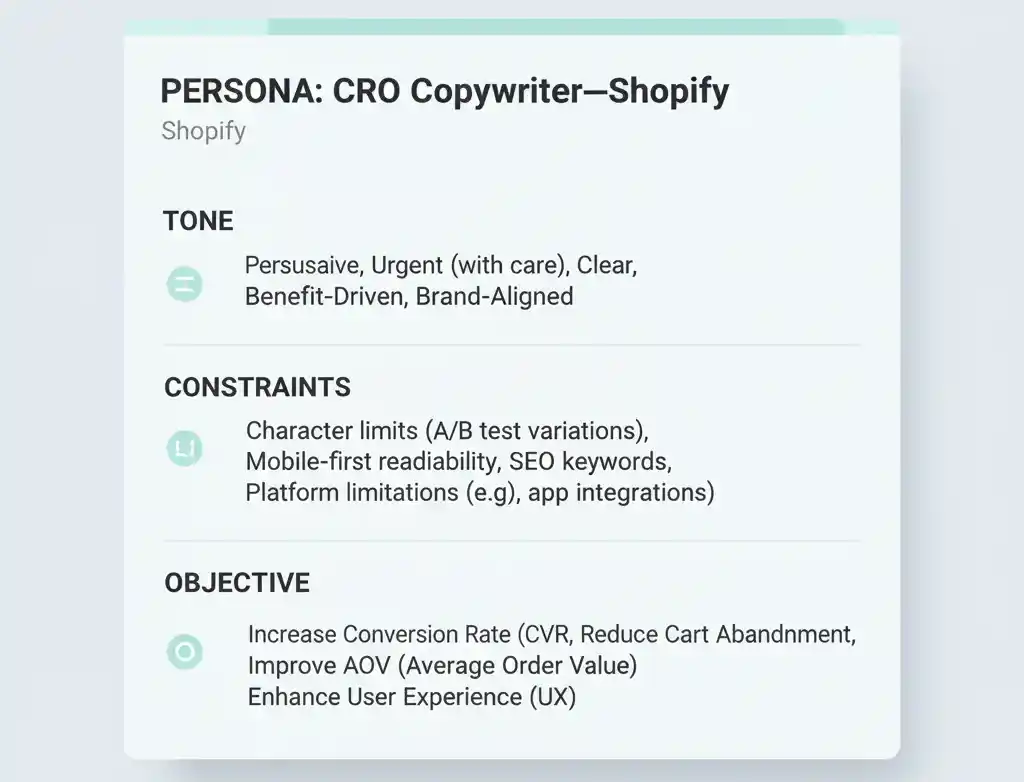
Treat each section as a reusable "shot bank," paste product data where indicated, and keep the output schema identical across SKUs for faster QA and CRO testing.
Pro Tip: Stack a copywriting framework (AIDA, PAS, BAB, FAB) with a prompt pattern (Persona, Few‑shot, Cognitive Verifier) to raise precision and reduce rewrites.
Section 1: AIDA Hooks and Heroes (20 shots)
AIDA excels at shaping the top of a product page: hook, value, desire, and a crisp action that matches buyer intent. Pair AIDA with Persona and Few‑shot patterns to keep your hero area and first-screen copy consistently on-brand across hundreds of items.
Before (weak): "Great headphones with many features."
After (AIDA, persona=Shopify CRO copywriter): "Hear more, carry less—[MODEL] delivers studio‑grade ANC in a travel‑light build; switch from flights to focus in one tap; claim the launch bundle now."

Copy-Paste Templates (20)
Act as an ecommerce CRO copywriter; write an AIDA hero for [PRODUCT] for [AUDIENCE] with [KEY_BENEFITS]; 18–24 words; end with a single imperative CTA.AIDA hook for [PRODUCT] solving [PRIMARY_PROBLEM]; use a visceral verb, 1 benefit, micro‑cred (e.g., 10k+ buyers), and CTA ≤ 4 words.AIDA hero variant; tone: playful; constraint: no adjectives >2 syllables; include a scannable benefit phrase in parentheses.AIDA hero variant; tone: premium; include 1 quantified proof (e.g., 28‑hour battery); CTA must match intent "Shop [CATEGORY]".AIDA above‑the‑fold for mobile; ≤16 words; include 1 emotion word and 1 outcome word; CTA: "See it in action".AIDA with scarcity; include real constraint [LIMIT/DEADLINE]; avoid hype; reflect stock [COUNT].AIDA in Hindi‑first for Bharat buyers; Hinglish allowed; ≤22 words; CTA in Hindi imperative.AIDA with social proof; insert [REVIEW_SNIPPET] in quotes; CTA aligned to risk reversal "Try it risk‑free".AIDA for gifting; include recipient archetype [WHO]; timebox [OCCASION_DATE]; CTA: "Gift now".AIDA eco angle; reference [MATERIAL/FOOTPRINT]; include one credible metric; CTA: "Choose greener".AIDA B2B; persona: procurement; include TCO cue and MOQ; CTA: "Request quote".AIDA for refurbished; emphasize testing standard and warranty; CTA: "Certified & ready".AIDA for bundles; articulate combined outcome vs. single SKU; CTA: "Bundle & save".AIDA for accessories; tie to parent device [PARENT_MODEL]; CTA: "Complete the setup".AIDA for preorders; include ship window and cancel‑anytime policy; CTA: "Reserve yours".AIDA for limited drops; include serialing/edition count; CTA: "Join the list".AIDA for seasonal; reference [SEASON/CLIMATE]; CTA: "Get set".AIDA for subscriptions; express per‑use math; CTA: "Subscribe & save".AIDA for upgrades; compare succinctly to prior model [OLD_MODEL]; CTA: "Upgrade now".AIDA for trials/samples; emphasize zero‑risk and fit assurance; CTA: "Sample first".
Section 2: PAS/BAB Body Copy (20 shots)
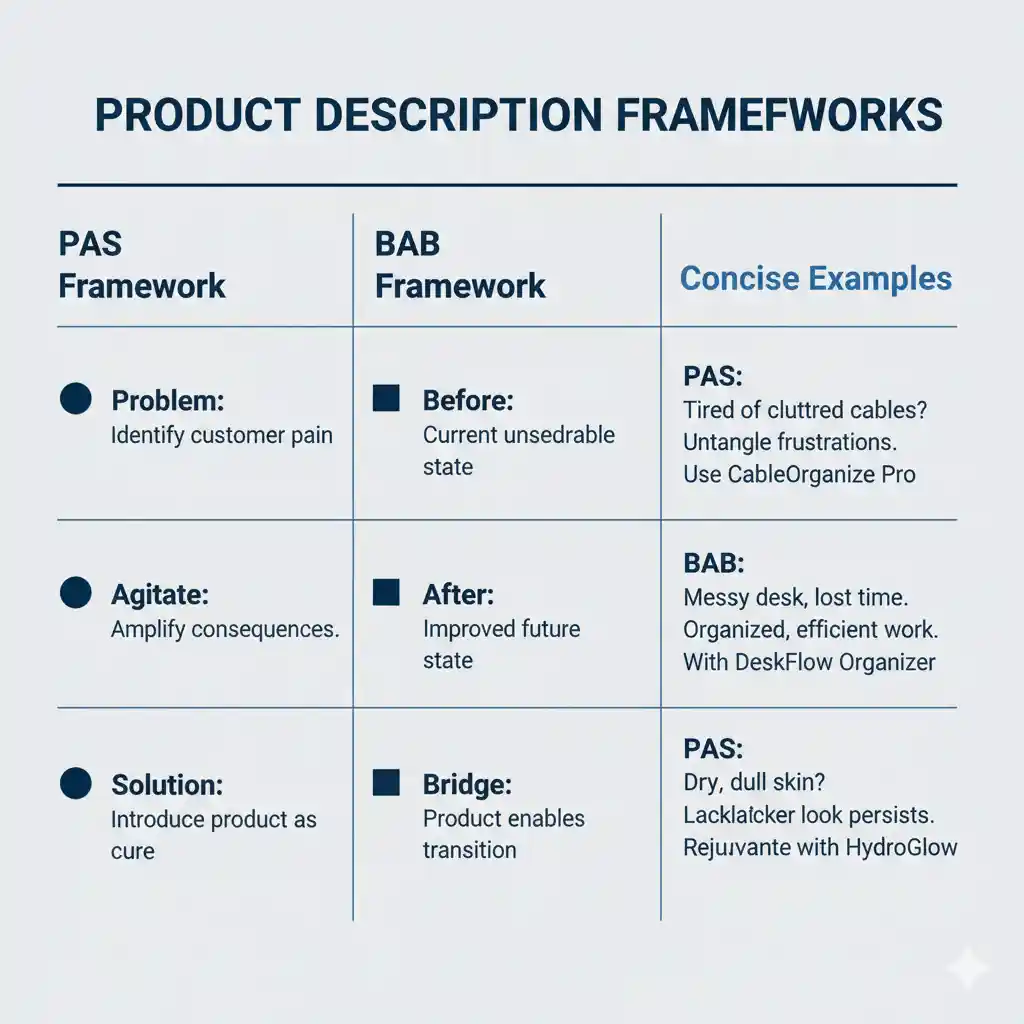
PAS surfaces the problem, sharpens pain, then presents your product as the direct solution, while BAB paints the before/after and bridges with your offer. Combine PAS/BAB for the main description to move skimmers from pain recognition to solution clarity without fluff.
Before (weak): "This chair is comfortable and stylish."
After (PAS→BAB): "Back aches and desk slouch steal your energy; posture fails when cushions flatten; meet [MODEL]—engineered lumbar, 4D arms, and breathable mesh; your 5pm back will feel like 10am again."
Copy-Paste Templates (20)
Write PAS for [PRODUCT] targeting [AUDIENCE]; problem must mirror a day‑in‑the‑life moment; solution maps 1:1 to that moment.PAS with social proof line at "Solution"; include "[X] verified buyers" tag.PAS with quantified agitation; introduce 1 credible stat about the problem domain.PAS in Hindi; keep agitation empathetic, not fear‑based; end with soft CTA.PAS variant for returns anxiety; solution includes fit/size safety net.PAS for tech setup dread; solution: 3‑step setup bullets and live chat availability.Write BAB for [PRODUCT]; "Before" is a vivid sensory scene; "After" is a specific new habit/routine.BAB + micro‑bridge naming your mechanism (e.g., "Dual‑Zone Airflow").BAB focusing on time saved per week; include simple math.BAB focusing on money saved per month; include realistic comparison.PAS for durability concerns; agitate with failure scenarios; solution: test standards + warranty length.PAS for sustainability skeptics; agitate greenwashing; solution: material + certification.BAB for gifting anxiety; after = recipient reaction narrative; bridge = unboxing experience.PAS for small‑space living; solution dimension callouts + storage cues.PAS for parents; solution: cleanability and safety certification.BAB for travelers; before = tangled cables; after = modular kit; bridge = labeled compartments.PAS for skincare; agitate routine fatigue; solution = regimen simplification with actives.PAS for audio; agitate noisy commute; solution = ANC + transparency mode clarity.BAB for cookware; before = hotspots; after = even sear; bridge = tri‑ply base.PAS for footwear; agitate heel pain; solution = arch support + return policy.
Section 3: FAB Feature Blocks (20 shots)
FAB turns raw specs into buyer‑relevant value by walking Features → Advantages → Benefits in tight, skimmable units. Use Few‑shot and Persona patterns to keep FAB blocks consistent across features and SKUs so comparison is effortless.
Before (weak): "Aluminum frame, 600D fabric, 3.2kg."
After (FAB): "Feature: 600D ripstop shell; Advantage: resists scuffs and frays on crowded transit; Benefit: looks new after months of daily carry."
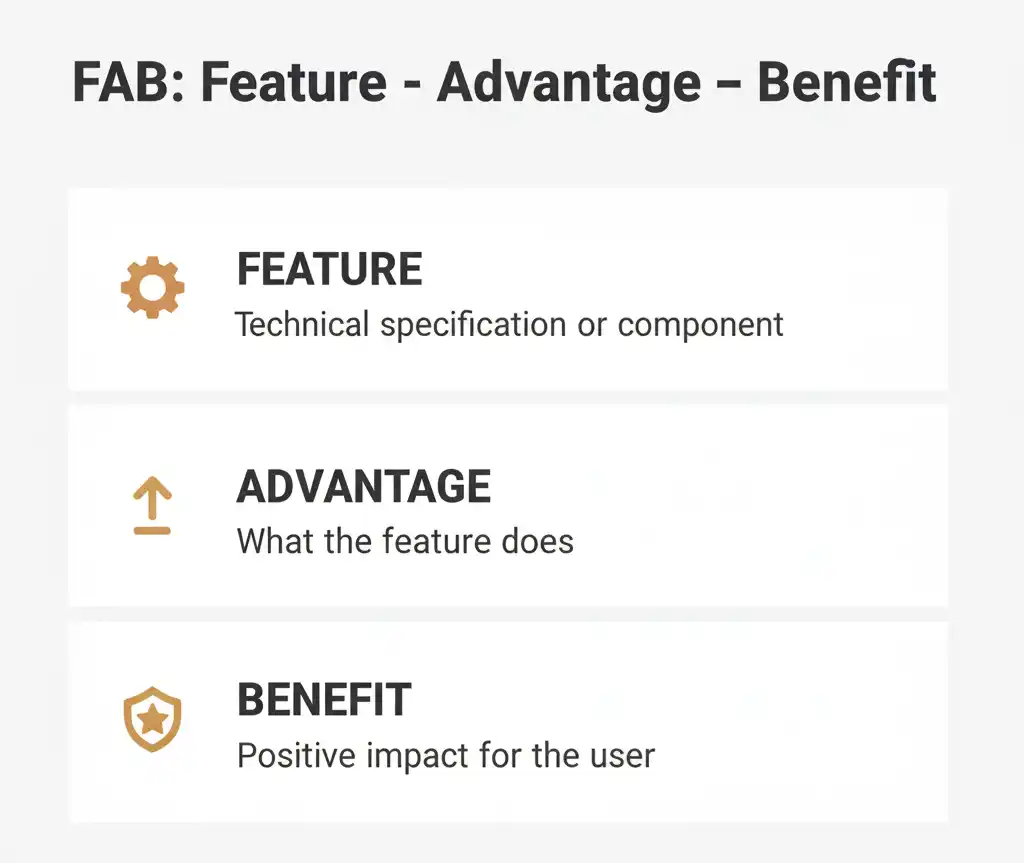
Copy-Paste Templates (20)
Write 3 FAB bullets for [PRODUCT]; 1 line each; no repeated benefits; avoid superlatives.FAB for battery spec; advantage = use case duration; benefit = fewer charge interruptions.FAB for material; advantage = durability/responsible sourcing; benefit = longer lifecycle.FAB for warranty; advantage = risk reduction; benefit = buyer peace of mind.FAB for dimensions/weight; advantage = portability/fit; benefit = daily convenience.FAB for sensors/actives; advantage = precision; benefit = noticeable outcome in [N_DAYS].FAB for connectivity; advantage = seamless pairing; benefit = zero‑friction switching.FAB for cleaning; advantage = easy maintenance; benefit = fresh look longer.FAB for thermal design; advantage = heat distribution; benefit = consistent results.FAB for lens/camera; advantage = clarity/low light; benefit = better memories.FAB for textiles; advantage = breathability/stretch; benefit = all‑day comfort.FAB for safety; advantage = certified standard; benefit = trust for family.FAB for packaging; advantage = minimal waste; benefit = guilt‑free unboxing.FAB for refill system; advantage = lower cost per use; benefit = sustainable savings.FAB for algorithm/software; advantage = smarter defaults; benefit = less tinkering.FAB for ergonomics; advantage = natural posture; benefit = pain reduction.FAB for storage; advantage = organized access; benefit = faster routines.FAB for grip/texture; advantage = secure handling; benefit = fewer drops.FAB for IP rating; advantage = weather‑safe; benefit = worry‑free use.FAB for build method; advantage = tighter tolerances; benefit = premium feel.
Section 4: Social Proof, Objections & FAQs (20 shots)
Mid‑page friction often hides in unspoken objections—use structured prompts to extract reviews, address doubts, and add credible micro‑proof. Stack Cognitive Verifier with PAS to ask for missing facts first and then answer with crisp, trust‑building copy.
Before (weak): "Customers love it; free returns."
After (objection handling): "Will it fit wide feet? Yes—[MODEL] uses a wider last and flexible knit. If it still pinches, return within 30 days, no questions asked."
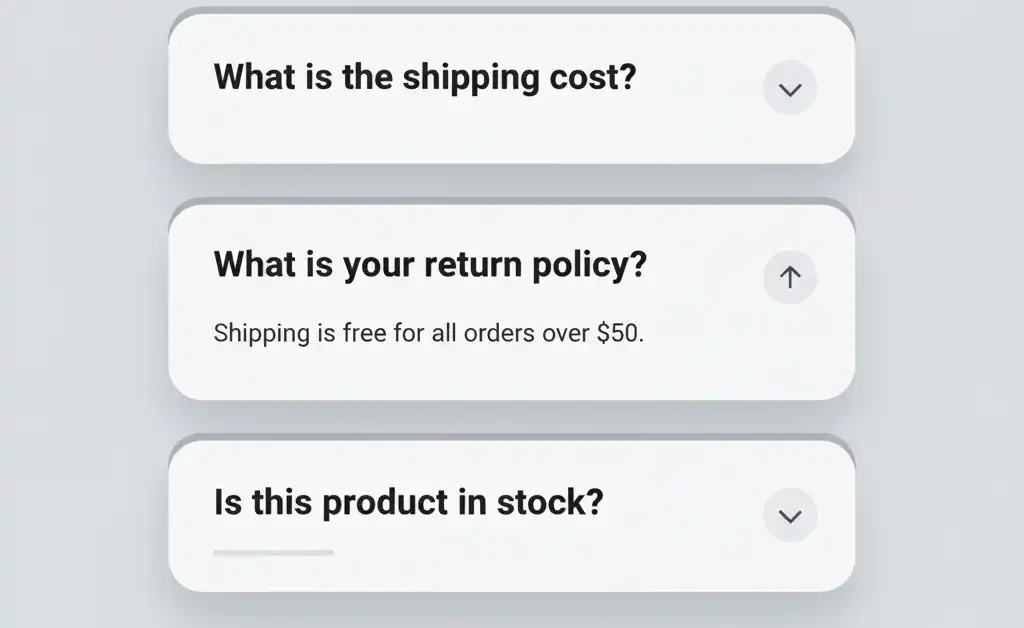
Copy-Paste Templates (20)
Turn [REVIEW_SNIPPET] into a 2‑line testimonial with a concrete outcome and use case tag.Summarize top 5 objections for [PRODUCT] from [REVIEWS/CS LOGS]; write one‑sentence answers each.Write a fit/size FAQ for [CATEGORY]; include measurement method and exchange policy.Create a "What's in the box" list; end with setup time estimate.Write risk‑reversal block referencing warranty/returns in plain language.Convert [Q&A] into a product FAQ; cluster by theme and order by impact.Draft social proof strip: "Trusted by [X] teams/creators/runners"; add 3 micro‑badges.Rewrite [REVIEW] to remove hype and keep a single measurable benefit.Turn [UGC_TRANSCRIPT] into a 3‑bullet "What I noticed in week 1/2/4".Write credibility line with certification/standard and why it matters.Create allergy/sensitivity disclaimer with safe alternatives suggestion.Write "Who it's for/Not for" block in two bullets each.Summarize "Care & maintenance" in 3 steps with time estimates.Write "Shipping & delivery" block with real lead times and tracking note.Draft "Comparisons" micro‑FAQ: [MODEL] vs [ALT]; 3 key differences.Write "Troubleshooting" for first‑use issues; 3 steps to fix.Turn [RETURNS_POLICY] into a friendly 3‑line explainer.Create an "Ethics & sourcing" micro‑note with one verifiable fact.Write "Accessibility" notes for [PRODUCT] with usage tips.Add "Contact us" micro‑CTA with expected reply time and channels.
Section 5: SEO, CTAs, and Variants (20 shots)

Tight product SEO requires consistent structure for titles, meta, bullets, and alt text, while CTAs must match the shopper's stage and device. Use Few‑shot prompts to lock formatting and reduce variance across thousands of SKUs while you A/B test calls to action.
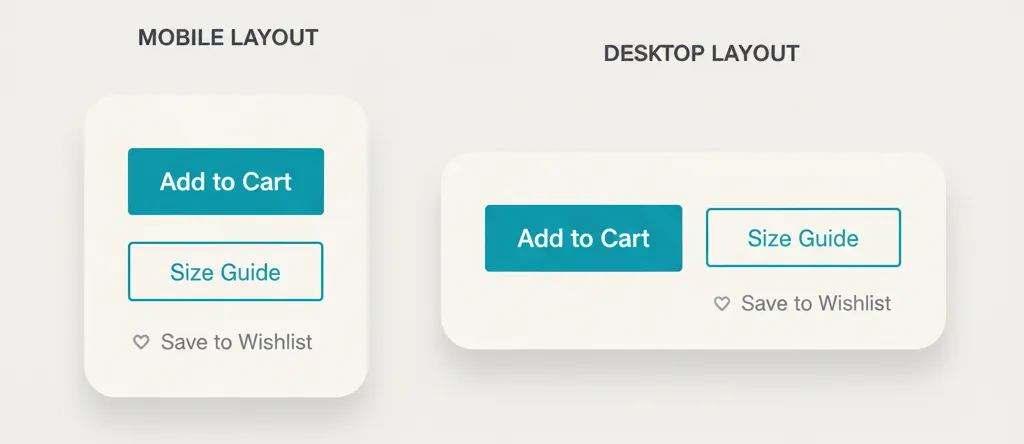
Before (weak): "Buy shoes online | Brand."
After (structured): "[Brand] [Model] running shoes—wide fit, 8mm drop, 30‑day free returns | Men's road trainers."
Copy-Paste Templates (20)
Write product title: [BRAND] [MODEL] [CATEGORY] — [PRIMARY_BENEFIT], [KEY_SPEC]; ≤65 chars.Write meta description for [PRODUCT]; ≤155 chars; include 1 benefit + policy cue.Write 5 SEO bullets; each starts with a noun; no end punctuation; one keyword each.Generate alt text for 6 gallery images; describe angle, color, and context.Write mobile CTA set (primary/secondary/tertiary) aligned to "Add to cart / Size guide / Save".Draft sticky‑bar CTA copy variants for low stock vs. preorder.Write internal link anchors to related collections; 5 anchors ≤4 words.Generate variant naming schema for color/material/finish with consistency rules.Write short swatch tooltips describing finish/texture.Write compare‑table row labels for [CATEGORY]; 8 consistent attributes.Write schema‑style key:value summary for quick specs; 8 lines.Write image captions focused on feature proof (e.g., test method).Draft cart‑cross‑sell copy for [ACCESSORY] tied to [PARENT_PRODUCT].Write bundle CTA lines expressing net outcome vs. single SKU.Write exit‑intent microcopy offering sample/try‑before‑buy.Write PDP micro‑survey (1 question + 3 options) to learn objection.Write back‑in‑stock signup microcopy; set expectation for timing.Write Klarna/EMI disclosure line; simple math per month.Write store pickup CTA and readiness estimate.Write accessibility note for keyboard/screenreader navigation on PDP.
Why These Patterns Work
AIDA, PAS, BAB, and FAB are time‑tested persuasion and clarity structures that directly map to product page sections, improving comprehension and conversion.
Persona, Few‑shot, and Cognitive Verifier prompt patterns reduce variance, enforce schemas, and front‑load clarifying questions for stronger first‑pass copy.
Implementation Tips
- Lock your schema: Keep examples in the prompt (few‑shot) so the model mirrors formatting for every SKU without drifting.
- QA your copy: Use a copy QA pass guided by the 4Cs—clear, concise, compelling, credible—before publishing to catch fluff and overclaims.
Quick Starter Example
Paste this once per new SKU for a comprehensive first draft.
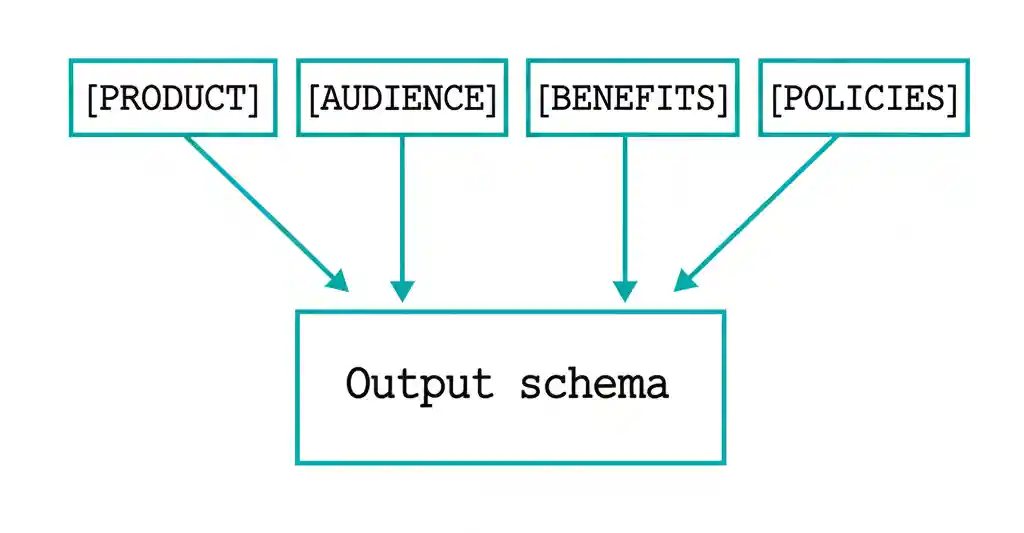
Act as an ecommerce CRO copywriter; product data: [PASTE SPECS/REVIEWS/POLICIES].
Return:
1) AIDA hero (≤22 words, 1 benefit, 1 proof, 1 CTA).
2) PAS paragraph (3 sentences, lived‑experience problem → solution).
3) FAB bullets x3 (Feature/Advantage/Benefit; one per line).
4) Objection micro‑FAQ x3 (Q: / A:).
5) SEO pack: title (≤65), meta (≤155), 5 bullets, 6 alt texts.
Use plain language; remove hype; preserve numerics; keep formatting exactly.
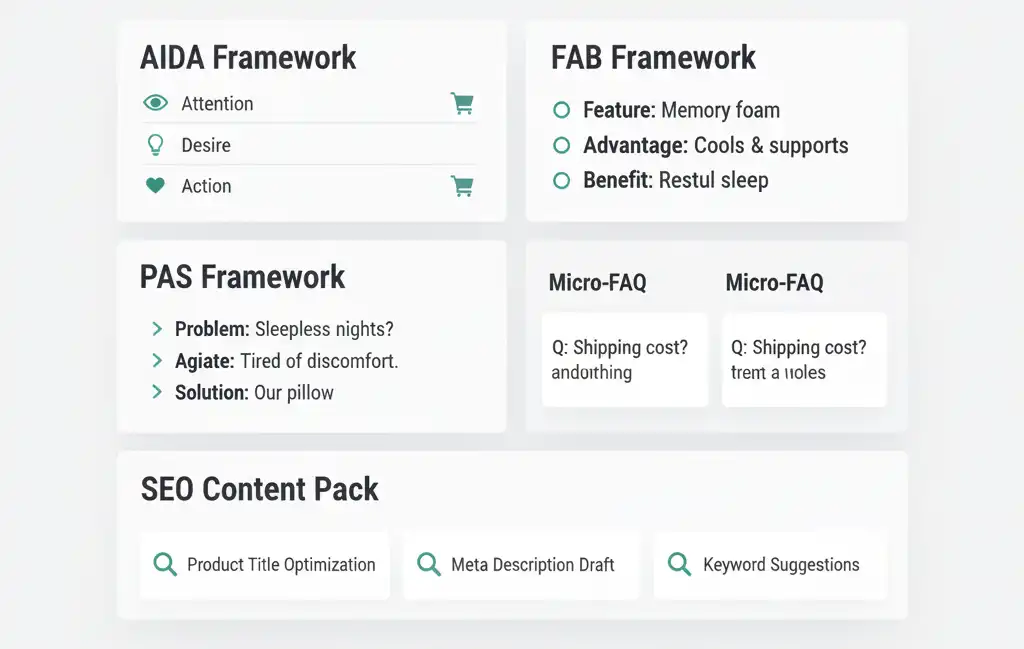
Layout & Compliance
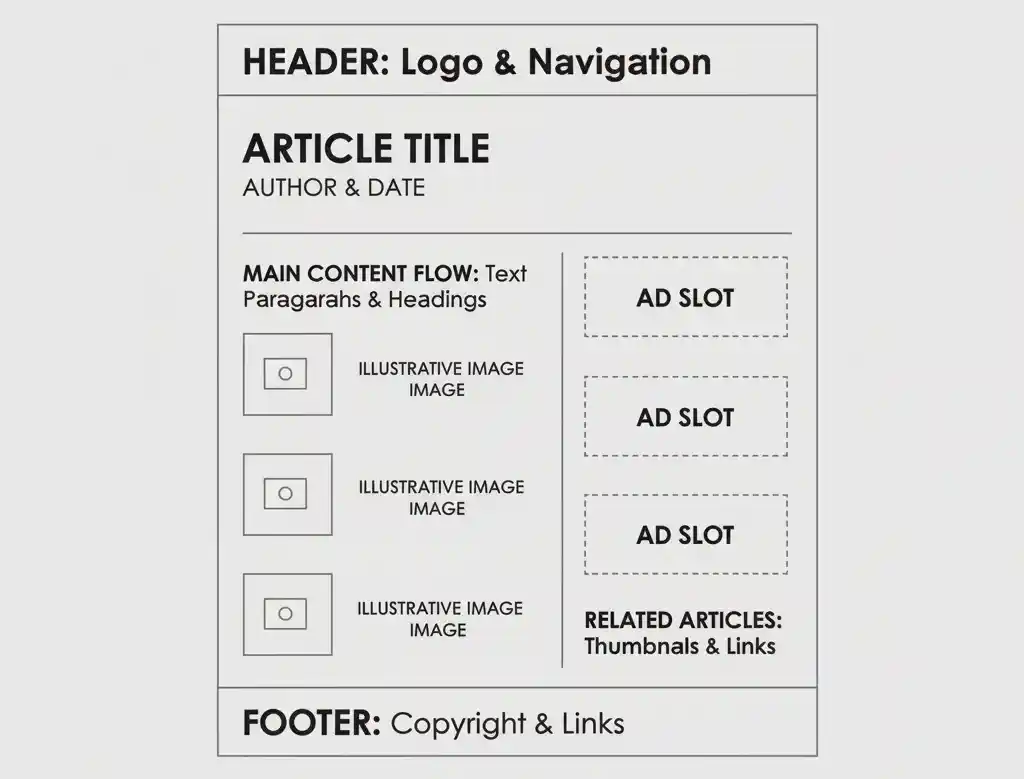
Ensure your product page layout clearly separates content, visuals, and ad placements. Maintain accessibility standards with proper heading hierarchy, alt text, and keyboard navigation support. Keep ad slots visually distinct from product information to maintain user trust and comply with advertising guidelines.
Implementation Workflow

Follow this systematic workflow: gather product data → select appropriate prompt pattern → generate AI copy → review and edit for accuracy → publish to your platform → analyze performance metrics → refine prompts based on conversion data. This iterative process ensures continuous improvement in your ecommerce copy quality.
